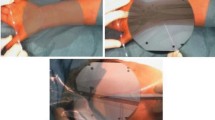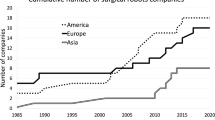Abstract
Purpose
Surgical navigation systems have demonstrated improvements in alignment accuracy in a number of arthroplasty procedures, but they have not yet been widely adopted for use in total shoulder arthroplasty (TSA). We believe this is due in part to the obtrusiveness of conventional optical tracking systems, as well as the need for additional intraoperative steps such as calibration and registration. The purpose of this study is to evaluate the feasibility of adapting a less-intrusive dental navigation system for use in TSA.
Methods
We developed a proof-of-concept system based on validated laser-engraved surgical tools recently introduced for use in dental surgery that are calibrated once when manufactured and not recalibrated at time of use. The design also features a notably smaller bone-mounted tracker that can be tracked from a wide range of viewing angles. To assess our system’s performance, we modified the dental surgical software to support guidance of a TSA procedure. We then conducted a user study in which three participants with varying surgical experience used the system to drill 30 holes in a glenoid model. Using a coordinate measuring machine, we determined the resulting drilled trajectory and compared this to the pre-planned trajectory. Since we used a model glenoid rather than anatomical specimens, we report on targeting precision rather than overall procedure precision or accuracy.
Results
We found targeting precision < 1 mm (standard deviation) for locating the entry hole and < ~ 1° (SD) for both version and inclination. The latter value was markedly lower than the end-to-end angular precision achieved by previously reported TSA navigation systems (approximately 3°–5° SD).
Conclusion
We conclude that variability during the targeting phase represents a small fraction of the overall variability exhibited by existing systems, so a less obtrusive navigation system for TSA based on laser-engraved tooling is likely feasible, which could improve the uptake rates of surgical navigation for TSA, thereby potentially leading to improved overall surgical outcomes.











Similar content being viewed by others
Availability of data and materials
Data is available upon request.
Change history
27 October 2021
Availability of data and materials: Data is available upon request.
References
Antuna SA, Sperling JW, Cofield RH, Rowland CM (2001) Glenoid revision surgery after total shoulder arthroplasty. J Shoulder Elbow Surg 10(3):217–224. https://doi.org/10.1067/mse.2001.113961
Bellemans J (2009) Navigation and CAS: Is D-day approaching? Knee Surg Sports Traumatol Arthrosc Off J ESSKA 17(10):1141–1142
Boddapati V, Fu MC, Schairer WW, Gulotta LV, Dines DM, Dines JS (2017) Revision total shoulder arthroplasty is associated with increased thirty-day postoperative complications and wound infections relative to primary total shoulder arthroplasty. HSS J 14(1):23–28. https://doi.org/10.1007/s11420-017-9573-5
Bouras T, Bitas V, Fennema P, Korovessis P (2015) Good long-term results following cementless TKA with a titanium plasma coating. Knee Surg Sports Traumatol Arthrosc 25(9):2801–2808. https://doi.org/10.1007/s00167-015-3769-3
Braun S, Schroeder S, Mueller U, Sonntag R, Buelhoff M, Kretzer JP (2018) Influence of joint kinematics on polyethylene wear in anatomic shoulder joint arthroplasty. J Shoulder Elbow Surg 27(9):1679–1685. https://doi.org/10.1016/j.jse.2018.02.063
Burns DM, Frank T, Whyne CM, Henry PD (2019) Glenoid component positioning and guidance techniques in anatomic and reverse total shoulder arthroplasty: a systematic review and meta-analysis. Shoulder Elbow 11(2 Suppl):16–28. https://doi.org/10.1177/1758573218806252
Farron A, Terrier A, Buchler P (2006) Risks of loosening of a prosthetic glenoid implanted in retroversion. J Shoulder Elbow Surg 15(4):521–526
Gauci MO, Boileau P, Baba M, Chaoui J, Walch G (2016) Patient-specific glenoid guides provide accuracy and reproducibility in total shoulder arthroplasty. Bone Joint J 98-B(8):1080–1085. https://doi.org/10.1302/0301-620x.98b8.37257
Habermeyer P, Magosch P, Luz V, Lichtenberg S (2006) Three-dimensional glenoid deformity in patients with osteoarthritis: a radiographic analysis. J Bone Joint Surg (Am) 88(6):1301–1307
Hollatz MF, Stang A (2014) Nationwide shoulder arthroplasty rates and revision burden in Germany: analysis of the national hospitalization data 2005 to 2006. J Shoulder Elbow Surg 23(11):e267–e274. https://doi.org/10.1016/j.jse.2013.12.008
Jain NB, Higgins LD, Guller U, Pietrobon R, Katz JN (2006) Trends in the epidemiology of total shoulder arthroplasty in the United States from 1990–2000. Arthritis Rheum 55:591–597. https://doi.org/10.1002/art.22102
Junnila M, Laaksonen I, Eskelinen A, Pulkkinen P, Havelin LI, Furnes O, Fenstad AM, Pedersen AB, Overgaard S, Kärrholm J, Garellick G, Malchau H, Mäkelä KT (2016) Implant survival of the most common cemented total hip devices from the Nordic Arthroplasty Register Association database. Acta Orthop 87(6):546–553. https://doi.org/10.1080/17453674.2016.1222804
Kircher J, Wiedemann M, Magosch P, Lichtenberg S, Habermeyer P (2009) Improved accuracy of glenoid positioning in total shoulder arthroplasty with intraoperative navigation: a prospective-randomized clinical study. J Shoulder Elbow Surg 18:515–520
Marani R, Renò V, Nitti M, Dorazio T, Stella E (2016) A modified iterative closest point algorithm for 3D point cloud registration. Comput Aided Civ Infrastruct Eng 31(7):515–534. https://doi.org/10.1111/mice.12184
Martin SD, Zurakowski D, Thornhill TS (2005) Uncemented glenoid component in total shoulder arthroplasty. J Bone Joint Surg Am 87(6):1284–1292. https://doi.org/10.2106/00004623-200506000-00014
Nashikkar PS, Scholes CJ, Haber MD (2019) Computer navigation re-creates planned glenoid placement and reduces correction variability in total shoulder arthroplasty: an in vivo case-control study. J Shoulder Elbow Surg 28(12):e398–e409. https://doi.org/10.1016/j.jse.2019.04.037
Shapiro TA, McGarry MH, Gupta R, Lee YS, Lee TQ (2007) Biomechanical effects of glenoid retroversion in total shoulder arthroplasty. J Shoulder Elbow Surg 16:S90–S95
Thienpont E, Paternostre F, Van Wymeersch C (2015) The indirect cost of patient-specific instruments. Acta Orthop Belg 81(3):462–470
Throckmorton TW, Gulotta LV, Bonnarens FO, Wright SA, Hartzell JL, Rozzi WB, Sperling JW (2015) Patient-specific targeting guides compared with traditional instrumentation for glenoid component placement in shoulder arthroplasty: a multi-surgeon study in 70 arthritic cadaver specimens. J Shoulder Elbow Surg 24(6):965–971. https://doi.org/10.1016/j.jse.2014.10.013
Trofa D, Rajaee SS, Smith EL (2014) Nationwide trends in total shoulder arthroplasty and hemiarthroplasty for osteoarthritis. Am J Orthop Belle Mead NJ 43:166–172
Wang AW, Wang AW, Hayes A, Gibbons R, Mackie KE (2019) Computer navigation of the glenoid component in reverse total shoulder arthroplasty: a clinical trial to evaluate the learning curve. J Shoulder Elbow Surg. https://doi.org/10.1016/j.jse.2019.08.012
Wong R, Jivraj J, Yang V (2014) Current limitations and opportunities for surgical navigation. Univ Toronto Med J 92(1):7–9
Acknowledgements
The authors thank Andres Medina and Tyler Dodds, Navigate Surgical Technologies, Vancouver, Canada, for their technical assistance
Funding
This work was supported by the Natural Sciences and Engineering Research Council Discovery Grants Programme.
Author information
Authors and Affiliations
Corresponding author
Ethics declarations
Conflict of interest
Antony Hodgson—The author declares that they have no conflict of interest. Oded Aminov—Worked as a co-op student at NST for 8 months in 2018. William Regan—The author declares that they have no conflict of interest. Maciej JK Simon—The author declares that they have no conflict of interest. Joshua W Giles—The author declares that they have no conflict of interest.
Ethics approval
No ethical approvals were required for this study.
Consent to participate
There were no participants in the study other than the named authors. This article does not contain patient or subject data.
Consent for publication
Not applicable.
Code availability
Not applicable.
Additional information
Publisher's Note
Springer Nature remains neutral with regard to jurisdictional claims in published maps and institutional affiliations.
Rights and permissions
About this article
Cite this article
Aminov, O., Regan, W., Giles, J.W. et al. Targeting repeatability of a less obtrusive surgical navigation procedure for total shoulder arthroplasty. Int J CARS 17, 283–293 (2022). https://doi.org/10.1007/s11548-021-02503-0
Received:
Accepted:
Published:
Issue Date:
DOI: https://doi.org/10.1007/s11548-021-02503-0




